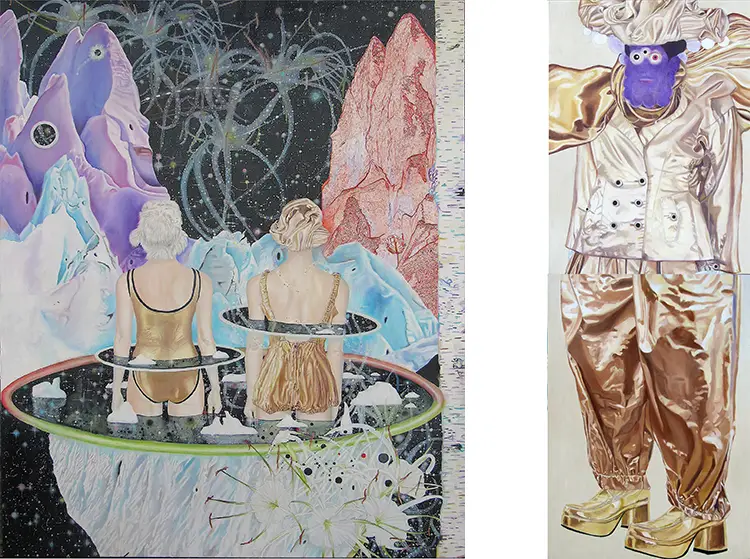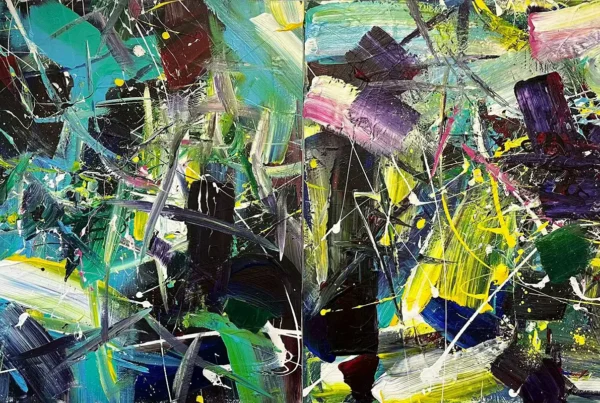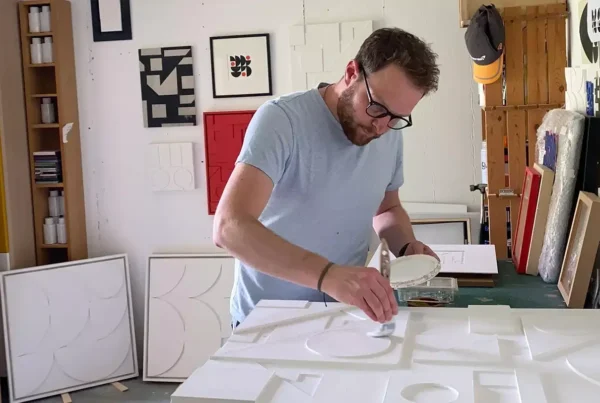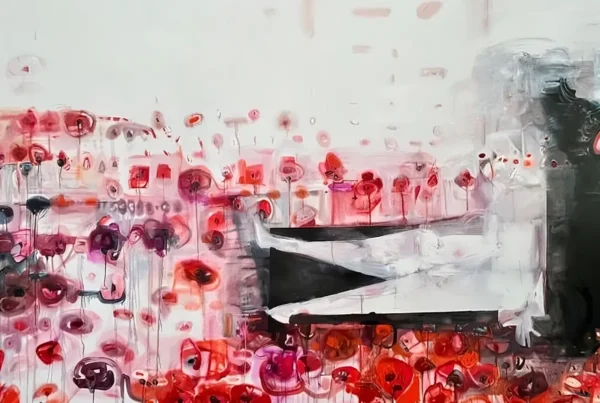“The white shadow is a complete portrait of my childhood and therefore close to my heart.”
Botanical Theatrics and Emotional Undercurrents
Eva Nordholt‘s art demands attention not through spectacle alone, but by suspending the viewer in a world where nature overwhelms, figures distort, and psychological nuance dances with aesthetic excess. Born in the Netherlands and now based in a forested enclave near Barcelona, Nordholt’s trajectory through Amsterdam, San Francisco, and Spain has forged a visual language rooted in constant reinvention. Her compositions, primarily executed in oil on canvas or wood, are rich with tension—between the hyperreal and the dreamlike, the decorative and the disquieting. Although her work might at first seem lush and ornamental, closer inspection reveals an unsettling poetry embedded in every fold of synthetic fabric and every haunted gaze.
What defines Nordholt’s visual signature is a profound sensitivity to materials and textures. Her paintings often depict reflective surfaces—plastics, silks, vinyls—that gleam with uncanny realism. These are not just technical feats; they suggest deeper layers of meaning. Such hyperreal renderings of synthetic fabrics allude to themes of performance, concealment, and the fragility of self-presentation. Figures in her work, often women and children, wear clothes that shimmer like armor yet appear vulnerable beneath their glossy sheen. Their bodies are stylized, their skin tinged with fantastical hues—emerald, cobalt, blush—removing them from literal interpretation and instead placing them in symbolic terrains.
Beyond her painterly technique, Nordholt’s sense of narrative sets her apart. Her scenes often evoke mythological or fairytale-like scenarios, without relying on overt storytelling. Flowers crowd the compositions, sometimes threatening to engulf the figures entirely, evoking both beauty and claustrophobia. Nature, in her universe, is never passive—it exerts presence and pressure, heightening the psychological undertone of her images. This baroque treatment of botanical life challenges the traditional hierarchy of figure and background, asking viewers to consider what truly holds power in her constructed worlds.
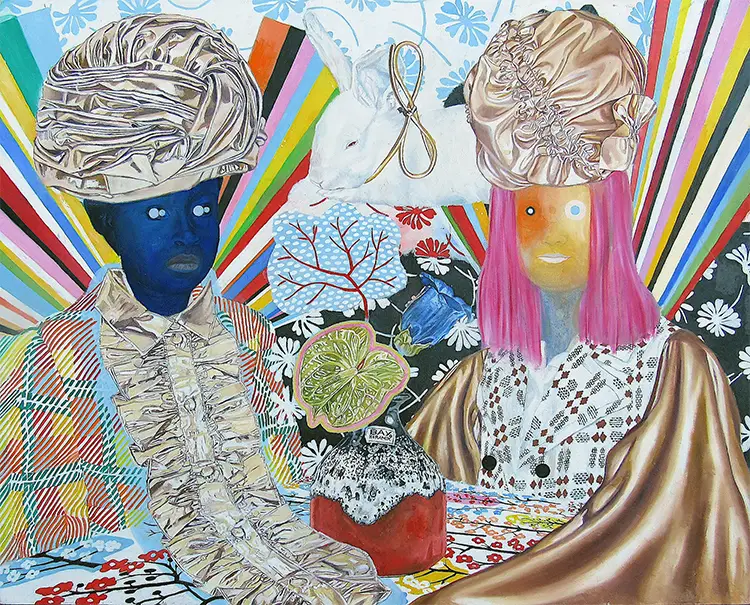
Eva Nordholt: The Lifelong Journey to Painting
Nordholt’s evolution into a painter was never a straight line, but it was always an inevitability. She recalls knowing she wanted to paint by the age of six, though the path was anything but direct. Formal arts education in Amsterdam did not prioritize painting at the time, so she explored other creative disciplines—illustration, graphic design, early computer graphics—each contributing a layer to her current practice. Her early adoption of digital tools, particularly during the nascent days of the internet, underscores a willingness to experiment and engage with emerging mediums, even as her final artistic home would be found in the oldest of them: oil painting.
Photography also played a pivotal role in her journey. For several years, Nordholt immersed herself in still life photography, focusing primarily on floral subjects, which she printed in cibachrome. This period clearly echoes in her current works, where botanical elements dominate with an obsessive intricacy. Yet, despite the skill and visual richness of her photographs, Nordholt’s creative compass continued to point toward painting. Eventually, she moved to San Francisco to earn a master’s degree in animation, a decision that, while seeming like another diversion, led her back to the core of her original artistic impulse. Through making a short film and developing her visual narrative skills, she found the freedom and confidence to commit fully to painting.
Since settling in Spain in 2015, Nordholt has further expanded her practice. The integration of silkscreen printing into her oeuvre, using digital design tools like Illustrator, reflects a hybrid approach that bridges handmade and digital processes. These silkscreens carry the same fascination with pattern, detail, and organic motifs found in her paintings, but offer a different kind of rhythm and repetition. Whether working on wood panels or limited edition prints, Nordholt maintains a commitment to storytelling through texture, color, and layered imagery. Her thematic focus—centered around people, flora, and the subtle radiance of gold—has remained constant even as her methods continue to evolve.
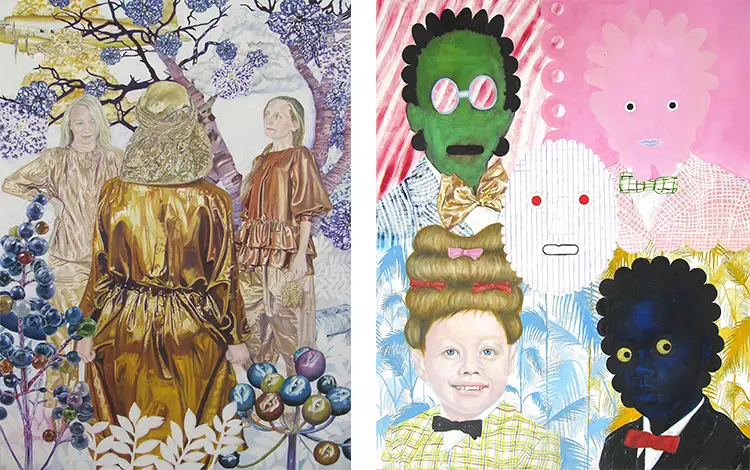
The White Shadow and the Mirror of Memory
Among her diverse body of work, The White Shadow holds a particularly intimate place in Nordholt’s heart. This oil on wood painting, measuring 100 by 100 centimeters, is not only a technical achievement but also a deeply personal reflection. For Nordholt, this piece functions as a distilled portrait of her childhood—a visual memoir encoded in pigments, patterns, and gesture. There is a haunting stillness to the composition, yet it resonates with emotional complexity. Though the viewer may not immediately grasp the autobiographical narrative, the sense of personal truth is palpable, as if the painting itself is engaged in quiet remembering.
This artwork exemplifies Nordholt’s ability to merge psychological resonance with surreal aesthetics. The figure within The White Shadow appears both present and spectral, embodying the duality of memory: its vivid immediacy and its inevitable fading. The surrounding details—perhaps botanical, perhaps ornamental—serve less as decoration and more as symbols of internal states. Here, gold does not function merely as a luxury element but becomes a conduit of emotional value, anchoring the ephemeral within something enduring. Nordholt’s use of oil on wood lends the work a sense of permanence, grounding the otherwise otherworldly scene.
The title itself, The White Shadow, suggests contrast and contradiction: light that casts darkness, purity tinged with ambiguity. Such dichotomies recur throughout Nordholt’s work, where beauty often masks unease, and opulence coexists with quiet melancholy. This painting, in particular, distills her stylistic and thematic concerns into a single, emotionally charged image. By choosing to highlight this piece, Nordholt invites viewers into her inner world—not through explicit storytelling, but through evocative atmosphere, detail, and symbolic density. It stands as a testament to her belief that art can communicate what words cannot, especially when rooted in the artist’s own lived experience.
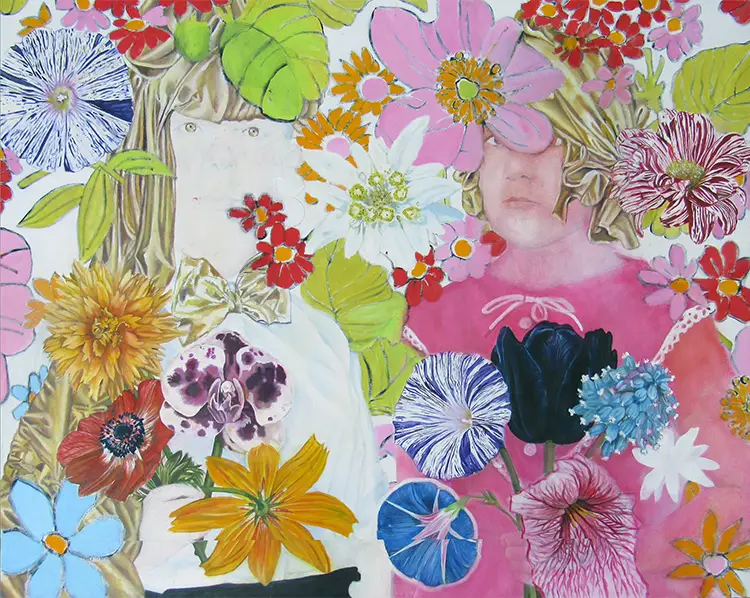
Eva Nordholt: Patterns, People, and Projects in the Forest
Each day in Nordholt’s life begins and ends in deep communion with the natural environment that surrounds her home. Living in a forested area near Barcelona, she paints outdoors for most of the year, using her terrace as a studio shaded by trees. This closeness to nature is not merely a lifestyle choice; it infuses her creative process. The rhythm of her routine—marked by daily painting and evening walks with her dogs—allows for both intensive focus and intentional mental unwinding. This setting, while serene, does not soften her drive. Nordholt works nearly every day, maintaining a rigorous practice that balances solitude with production.
At present, Nordholt is revisiting older paintings that once served as studies or technical exercises. These works, while once valuable for learning, no longer resonate with her current sensibilities. By recycling and reworking them, she engages in a kind of creative archaeology—unearthing past intentions and repurposing them into something more aligned with her present vision. This act of transformation speaks to a broader theme in her work: the layering of identities, stories, and surfaces. Old canvases become the substrate for new ideas, much like how patterns in her paintings function as carriers of history and emotion.
Looking ahead, Nordholt is especially drawn to the development of a new project she describes as “gilded people.” This forthcoming series will likely depict a family, exploring ideas of identity, legacy, and perhaps the mythologizing of the domestic. The use of gold, already a familiar element in her work, will take on a more central role—not just as a visual accent, but as a conceptual anchor. Parallel to this, she remains excited about creating new silkscreens, a medium that allows her to distill her interest in pattern and nature into graphic, rhythmic compositions. Whether painting, printing, or reworking older materials, Nordholt continues to navigate her artistic practice with both precision and curiosity, guided by a lifelong fascination with image-making.
